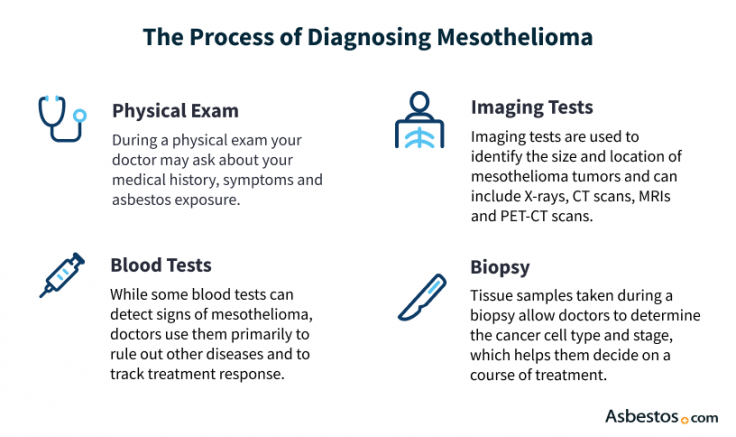
Dr. Jacques Fontaine is a thoracic surgeon at Moffitt Cancer Center in Tampa, Florida, where he heads up the Mesothelioma Research and Treatment Center. He specializes in minimally invasive robotic surgery and aggressive surgeries for mesothelioma.
Doctors use several tests to diagnose mesothelioma, including imaging scans, blood tests and biopsies. Imaging and lab tests can show signs of cancer, but only a biopsy confirms mesothelioma. Testing early and working with a specialist helps improve accuracy and outcomes.

Expert Take
Dr. David Sugarbaker: How Is Mesothelioma Diagnosed?

Expert Take
Dr. David Sugarbaker: How Is Mesothelioma Diagnosed?
Mesothelioma diagnosis may involve a combination of tests, including a physical exam, imaging tests, fluid analysis and biopsies to confirm this rare cancer.
Mesothelioma tests depend on your symptoms and where your tumor is located. Doctors often start with imaging scans and blood tests before confirming the diagnosis through a biopsy, which is the only way to definitively identify mesothelioma cells.
Diagnosing mesothelioma can be challenging because signs of the disease are similar to other conditions. If you and your doctor have discussed your history of asbestos exposure and symptoms, they may suspect mesothelioma. Asbestos exposure is the primary risk factor for mesothelioma and the first aspect doctors consider when beginning the diagnostic process. Early detection is crucial because identifying mesothelioma earlier can expand treatment options and improve outcomes.
Key Tests to Diagnose Mesothelioma
Learn about your diagnosis, top doctors and how to pay for treatment in our free mesothelioma guide.
Get Your GuideYour doctor may refer you to an oncologist for further tests for mesothelioma. Your oncologist will listen for sounds indicating fluid buildup, a common sign of mesothelioma. Then, you’ll likely have imaging tests to identify where tumors are located and how far they’ve spread, a process known as staging the disease.
A biopsy is the most important test in confirming a mesothelioma diagnosis. Although other tests provide clues, only a biopsy and the resulting pathology report can confirm mesothelioma with certainty. A pathologist will use a microscope to study the tissue or tumor sample collected during your biopsy and write up their findings. Pathology reports show the specific type of mesothelioma cells in your sample. Identifying the cell type (epithelioid, sarcomatoid or biphasic) is essential because it directly influences prognosis and treatment options.

If you have chest pain, trouble swallowing, shortness of breath or back pain and you were exposed to asbestos, see your doctor. First, your doctor will discuss your medical history and ask about asbestos exposure.
Then, your doctor will do a physical exam, checking for symptoms of mesothelioma, such as fluid buildup in your chest (pleural effusion) or in your belly (ascites). They’ll check for fluid around your heart (pericardial effusion). In rare cases of testicular mesothelioma, they’ll perform a physical examination of the groin area.

Learn about your diagnosis, top doctors and how to pay for treatment in our updated 2025 guide.
Get Your Free GuideRadiologists use mesothelioma imaging tests, including PET scans, X-rays, echocardiograms, CT scans and MRIs, to locate and assess mesothelioma tumors. Some scans involve contrast dye. Most scans are generally quick and painless. MRIs can take 30 to 90 minutes.
Types of Mesothelioma Imaging Scans
Doctors use imaging scans to see signs of asbestos exposure. They look for hardened areas on the lung lining called pleural plaques. These signs and other tests help doctors see if an asbestos-related disease is present.
Some scans such as MRIs may cause anxiety in some patients. Health care providers may prescribe anti-anxiety medications. These drugs help patients relax during the scan.
The day I found out I was diagnosed with mesothelioma, I was pretty scared. I was shocked. I was in shock. I felt like I was in the Twilight Zone. When they told me I was diagnosed with mesothelioma, no one knew what it was. I didn’t know what it was. My mom, my husband, no one. It was the day my whole life changed.
Doctors sometimes order blood tests as part of the mesothelioma testing process. These tests look for certain proteins, white blood cell levels and other possible signs called biomarkers. However, these blood markers aren’t only found in people diagnosed with mesothelioma. Doctors use blood tests like MESOMARK, N-ERC/mesothelin and fibulin-3 blood tests to get clues, but they need a biopsy to confirm a mesothelioma diagnosis. Blood tests alone can’t diagnose mesothelioma.
Fibulin-3 is a protein your body makes to help build and support connective tissues. Mesothelioma cells can release extra fibulin-3, which leads to higher levels in the blood. But higher levels can also show up with other cancers like cervical cancer. Similarly, the MESOMARK blood test looks for molecules called soluble mesothelin-related peptides. Mesothelioma cells make SMRPs. But SMRPs have also been found in ovarian and pancreatic cancer.
Researchers are studying new types of tests. In 2025, the American Society of Clinical Oncology started to recommend genetic testing. Genetic testing often involves blood and saliva tests. A 2024 review reports up to 10% of patients diagnosed with mesothelioma have what’s known as a BAP1 mutation. They tend to respond better to chemotherapy. Patients with this mutation have a median survival of 5 years.
Mesothelioma cytology tests help doctors find cancer cells in fluid. Doctors collect samples from effusions or ascites from the chest, abdomen or around the heart. Then, they use a microscope to search for mesothelioma cells. If they find these cells, it helps them diagnose mesothelioma.
Types of Mesothelioma Cytology Tests
Both cytology tests and biopsies help diagnose mesothelioma, according to a 2024 study published in the Journal of the American Society of Cytopathology. The key difference between the two tests is cytology tests look at fluid, while biopsies take tissue samples. Biopsies give more information about cancer cells, which is how doctors determine whether you have mesothelioma.
A biopsy is the best test for confirming a mesothelioma diagnosis. This medical procedure takes a sample of tissue that’s studied under a microscope to check for cancer cells.
Doctors suggest a biopsy if you show signs of mesothelioma. Imaging scans, such as CT or PET scans, help guide where the sample should be taken from and assess cancer spread. Because fluid tests alone often cannot confirm mesothelioma, a tissue biopsy is essential for an accurate diagnosis and for determining the cell type and stage of the disease.
Types of Mesothelioma Biopsies
Thoracic surgeon Dr. Jeffrey Velotta tells us, “The diagnosis of mesothelioma is very difficult. Fluid, the majority of the time, 70% to 80% of the time will not tell you if you have mesothelioma or not. There’s just not enough cells in the fluid. You actually need tissue. I recommend all patients undergo biopsy as soon as possible and not wait.”
Mesothelioma staging is part of the diagnostic process. It describes how far tumors have spread, which can be seen on imaging scans. The 4 stages of mesothelioma range from early stage (stages 1 and 2) to late stage (stages 3 and 4). The higher the number, the more the cancer has spread from where it started.
Staging helps doctors plan the best treatment. An early-stage diagnosis improves treatment options. A late diagnosis makes these treatments less effective. Later stages become more difficult to treat.
The TNM staging system is the official method for staging pleural mesothelioma. It describes tumor size, lymph node involvement and cancer spread to distant organs, helping doctors plan the most effective treatment.
Thoracic Surgeon and Director of the New York Mesothelioma Program at Mount Sinai Dr. Andrea Wolf, tells us, “When staging mesothelioma, I assess where the cancer is located, how far it has spread, and which organs are involved. This information is essential in developing the most effective treatment plan for each of my patients.”
| Stage at Diagnosis | % of Respondents |
|---|---|
| Stage 1 | 12% |
| Stage 2 | 17% |
| Stage 3 | 23% |
| Stage 4 | 48% |
Diagnosing mesothelioma is difficult because its symptoms mimic more common illnesses like bronchitis or pneumonia. The latency period between asbestos exposure and mesothelioma can be 20 to 60 years. So when symptoms show up decades later, an asbestos-related disease like mesothelioma may not immediately come to mind.
Mesothelioma misdiagnosis is unfortunately common, especially with doctors unfamiliar with this rare malignant cancer. This makes getting a second opinion from an asbestos-related cancer expert so important if you’ve had a history of asbestos exposure. But some people aren’t aware they’ve been exposed, making it even more challenging.
Patient Advocate and VA-accredited claims agent Danielle DiPietro tells us, “Many patients we speak with have told us they were diagnosed after going to the hospital for what they thought was an unrelated symptom.”
Mesothelioma survivor Wendy M. Phillips confirms this was the case for her. She tells us, “I went to the hospital with a swollen arm and was initially told I had a blood clot. Mesothelioma tumors were blocking my lymph nodes.”
Finding mesothelioma early is very important because it allows doctors to start treatment sooner. An early diagnosis and guidance from a mesothelioma specialist can offer more treatment options and better outcomes. This can improve survival and quality of life.
However, according to the Centers for Disease Control and Prevention, early detection is still rare. From 2017 to 2021, 70.9% of mesothelioma cases were diagnosed after stage 1.
Pleural mesothelioma survivor Kevin Hession is an unusual example of someone diagnosed early. He tells us, “After my surgery, I was told my mesothelioma was stage 1-B.” His diagnosis in 2021 followed 4 cases of pleurisy, which is inflammation around the lungs. Ongoing chemotherapy is helping him manage the disease.

Filled with thoughtful items to bring comfort and encouragement while undergoing treatment.
Get Your Free KitOnce you receive a mesothelioma diagnosis, it’s important to begin planning your mesothelioma treatment with your doctor. Often in this process, people have questions about and want another perspective on the best treatment for them. Getting a second opinion from an expert can make you aware of other approaches, new therapies or available clinical trials. Because mesothelioma is rare, consulting a mesothelioma specialist reduces the risk of misdiagnosis and ensures access to the latest treatment options.
Patient Advocate Snehal Smart, M.D., tells us, “Most people who contact us about diagnosing mesothelioma are looking for a second opinion. We can connect them with treatment specialists and arrange appointments and treatment if they do receive a confirmed mesothelioma diagnosis.”
Next Steps After a Mesothelioma Diagnosis
Peritoneal mesothelioma survivor Tamron Little knows the importance of a second opinion firsthand. She shares with us, “At first, I was under the care of an oncologist who said he knew nothing about mesothelioma. But I finally found the right mesothelioma specialist. I was presented with a roadblock and decided to go around it.”
A mesothelioma diagnosis can feel overwhelming, but you don’t have to go through it alone. Patient Advocates help people understand treatment options, schedule appointments, navigate insurance and explore financial support for medical expenses.

Dr. Catherine Perrault, medical officer and board-certified family physician with The Mesothelioma Center’s Medical Outreach Team
People with a history of asbestos exposure and symptoms such as chest pain or shortness of breath should ask their doctor about testing for mesothelioma. They may recommend imaging scans, blood tests and a biopsy to diagnose mesothelioma.
About 3 months is the average time it takes to get a mesothelioma diagnosis. This is after the first symptoms appear. The most common symptoms include shortness of breath and chest pain.
The first step in preparing for a mesothelioma biopsy is to stop all blood-thinning meds at least 5 days before your biopsy. Don’t eat or drink anything 6 hours before your appointment. Wear loose clothes to the appointment. Also, arrange for a designated driver to take you home. Plan to spend several hours undergoing the biopsy. Some biopsies need at least one night in the hospital.
Stay up-to-date on treatment, research, clinical trials, doctors and survivors
The information on this website is proprietary and protected. It is not a substitute for professional medical advice, diagnosis or treatment. Any unauthorized or illegal use, copying or dissemination will be prosecuted. Please read our privacy policy and terms of service for more information about our website.
This website and its content may be deemed attorney advertising. Prior results do not predict a similar outcome.
The Mesothelioma Center’s claim as the most trusted resource is based on our more than 150 5-star Google and BBB reviews. Our organization also helps more than half of all mesothelioma patients annually diagnosed.
Your web browser is no longer supported by Microsoft. Update your browser for more security, speed and compatibility.
If you are looking for mesothelioma support, please contact our Patient Advocates at (855) 404-4592
The Mesothelioma Center at Asbestos.com has provided patients and their loved ones the most updated and reliable information on mesothelioma and asbestos exposure since 2006.
Our team of Patient Advocates includes a medical doctor, a registered nurse, health services administrators, veterans, VA-accredited Claims Agents, an oncology patient navigator and hospice care expert. Their combined expertise means we help any mesothelioma patient or loved one through every step of their cancer journey.
More than 30 contributors, including mesothelioma doctors, survivors, health care professionals and other experts, have peer-reviewed our website and written unique research-driven articles to ensure you get the highest-quality medical and health information.
My family has only the highest compliment for the assistance and support that we received from The Mesothelioma Center. This is a staff of compassionate and knowledgeable individuals who respect what your family is experiencing and who go the extra mile to make an unfortunate diagnosis less stressful. Information and assistance were provided by The Mesothelioma Center at no cost to our family.LashawnMesothelioma patient’s daughter


Asbestos.com. (2025, October 23). Mesothelioma Diagnosis. Retrieved December 18, 2025, from https://www.asbestos.com/mesothelioma/diagnosis/
"Mesothelioma Diagnosis." Asbestos.com, 23 Oct 2025, https://www.asbestos.com/mesothelioma/diagnosis/.
Asbestos.com. "Mesothelioma Diagnosis." Last modified October 23, 2025. https://www.asbestos.com/mesothelioma/diagnosis/.
We Thoroughly vet individuals who are experts in their field to contribute to articles on Asbestos.com. We believe in the integrity and quality of our educational materials, and only publish information that is relevant, factual, and backed by experts.

Dr. Jacques Fontaine is a thoracic surgeon at Moffitt Cancer Center in Tampa, Florida, where he heads up the Mesothelioma Research and Treatment Center. He specializes in minimally invasive robotic surgery and aggressive surgeries for mesothelioma.
Our fact-checking process begins with a thorough review of all sources to ensure they are high quality. Then we cross-check the facts with original medical or scientific reports published by those sources, or we validate the facts with reputable news organizations, medical and scientific experts and other health experts. Each page includes all sources for full transparency.
Please read our editorial guidelines to learn more about our content creation and review process.
